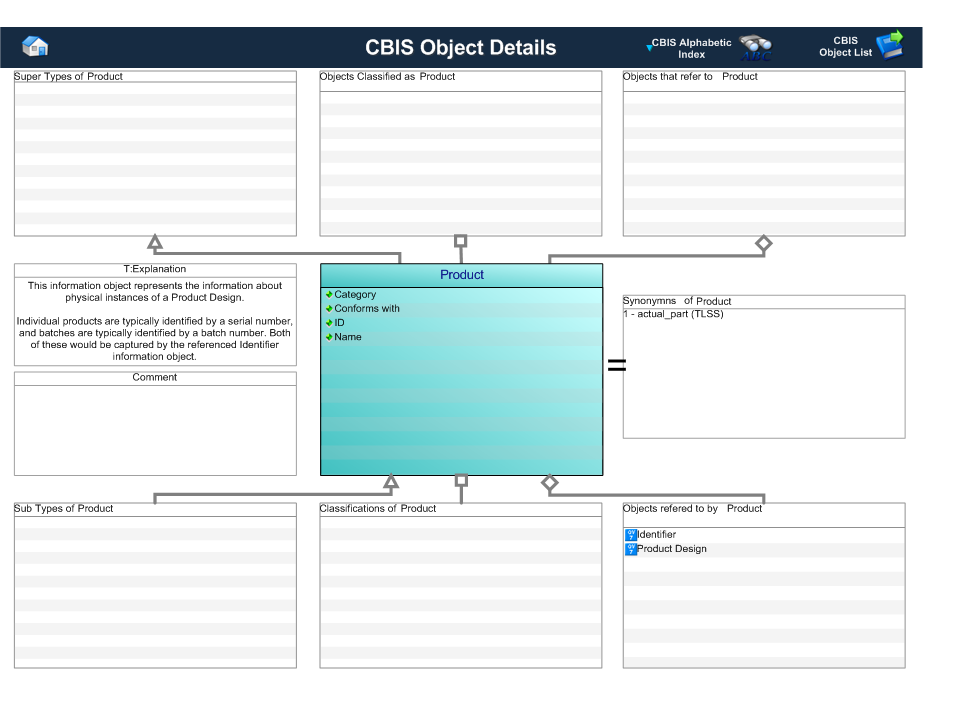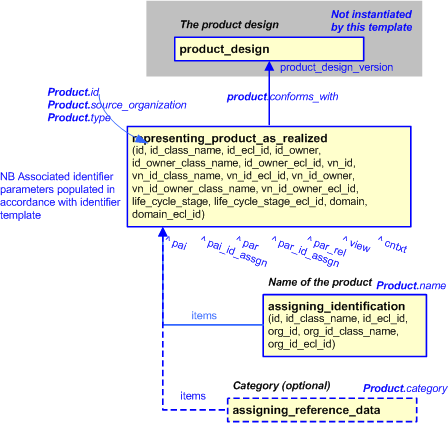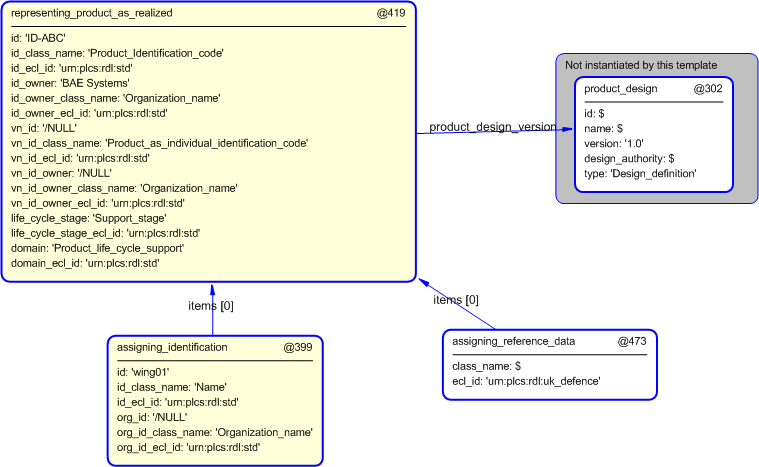Template:— product (prod)
Context:— UK_Defence |
Date: 2009/11/05 14:33:09
Revision: 1.5
|
This section specifies the template product.
NOTE
The template has been defined in the context of
UK_Defence.
Refer to the business context for details of related templates.
NOTE
An explanation of a template and the associated instantiation path is
provided in the
Template overview
section.
This template describes how to represent a UK_Defence product, using
Product_as_realized.
It enables the identification of the physical product and its related Part, and provides the mechanism
to assign reference data, dates, properties, documents, etc. to the physical product.
For further information about the representation of a product, see below.
This information object represents the information about a physical instance of a Product Design.
Individual products are typically identified by a serial number.
Figure 1 — Graphical Representation for Business Object Product
Record:
This information object represents the information about a physical instance of a Product Design.
|
Attribute name
|
Attribute description
|
Attribute type
|
Optionality
|
| Category |
This is a category that may be applied to a specific product. |
Intrinsic |
Optional |
| Conforms with |
This is the reference to the product design to which the product conforms. |
Product Design |
Mandatory |
| ID |
This is the identifier of the product. |
Identifier |
Mandatory |
| Name |
This is the name of the product. |
intrinsic |
Mandatory |
Table 1 — Product attribute details
The EXPRESS-G diagram in
Figure
2
shows the templates and EXPRESS entities that are required
to represent the template
"product".
The text highlighted in blue shows the template parameters.
Figure 2 — An EXPRESS-G representation of the Information model for product
The graphic for the template to be used in other EXPRESS-G diagrams
is shown in Figure
3
below.
Figure 3 — The graphical representation of the product template
The following input parameters are defined for this template:
This is a category that may be applied to a specific product.
The identifier of the product.
The organization or information system that created the associated identifier. Alternatively
this could be set to "/NULL" when Person or Information System is the source; see Identifier template characterizations
This is the name of the type of the class used to classify the identifier and so
provide the role or reason for the identification.
The following classes and their sub-classes can be used:
The following reference parameters are defined for this template:
Allow the
Product_as_individual
entity instantiated in this path to be referenced when this template is used.
%^target = $product.pai%
%^target = $product.pai_id_assgn%
Allow the
Product_as_realized
entity instantiated in this path to be referenced when this template is used.
%^target = $product.par%
%^target = $product.par_id_assgn%
%^target = $product.par_rel%
%^target = $product.view%
%^target = $product.cntxt%
The following parameter combinations specify a uniqueness constraint:
Unique constraint: Unique product
Each instance of the
entity
(
Product_as_individual)
within the data set shall be uniquely identified
by a combination of the following parameters on this
template (product) namely:
conforms_with,
ID.
The
instance is
referenced by the following template parameter:
pai.
The product should only occur once in a data set.
The instantiation path shown below specifies the entities that are to be
instantiated by the template.
A description of templates and the syntax for the instantiation path is
provided in the
Templates Help/Information section.
-- instantiate Product_as_realized /
representing_product_as_realized(
id=@ID,
id_class_name=@type,
id_ecl_id='urn:plcs:rdl:std',
id_owner=@source_organization,
id_owner_class_name='Organization_identification_code',
id_owner_ecl_id='urn:plcs:rdl:std',
vn_id='/NULL',
vn_id_class_name='Product_as_individual_identification_code',
vn_id_ecl_id='urn:plcs:rdl:std',
vn_id_owner='/NULL',
vn_id_owner_class_name='Organization_name',
vn_id_owner_ecl_id='urn:plcs:rdl:std',
life_cycle_stage='Support_stage',
life_cycle_stage_ecl_id='urn:plcs:rdl:std',
domain='Product_life_cycle_support',
domain_ecl_id='urn:plcs:rdl:std',
product_design_version=@conforms_with)/
%^pai = $representing_product_as_realized.pai%
%^pai_id_assgn = $representing_product_as_realized.pai_id_assgn%
%^par = $representing_product_as_realized.par%
%^par_id_assgn = $representing_product_as_realized.par_id_assgn%
%^par_rel = $representing_product_as_realized.par_rel%
%^view = $representing_product_as_realized.view%
%^cntxt = $representing_product_as_realized.cntxt%
-- instantiate assigning_identification for the product's name /
assigning_identification(
id=@name,
id_class_name='Name',
id_ecl_id=''urn:plcs:rdl:std',
org_id='/NULL',
org_id_class_name='Organization_name',
org_id_ecl_id='urn:plcs:rdl:std',
items=^pai)/
-- provide the Optional category of the Product by classifying the pai /
assigning_reference_data(
items=^pai,
class_name=@category,
ecl_id='urn:plcs:rdl:uk_defence')/
The instance diagram in Figure
4
shows an example of the EXPRESS entities and templates that are instantiated by the template:
/product(category='', conforms_with='#302', id='ID-ABC', source_organization='BAE Systems', type='Product_Identification_code', name='wing01')/
(an illustration of the consolidated product template is shown in
Figure
5 below.)
Figure 4 — Entities instantiated by product template
The instance diagram in
Figure
5
shows the graphic symbol for the template that is to be
used in other instance diagrams. The example template is:
/product(category='', conforms_with='#302', id='ID-ABC', source_organization='BAE Systems', type='Product_Identification_code', name='wing01')/
Figure 5 — Instantiation of product template
Characterizations
No common characterizations of the template
product
have been identified. However, the ISO 10303-239 EXPRESS model
may enable other assignments to the entities instantiated by the template.




